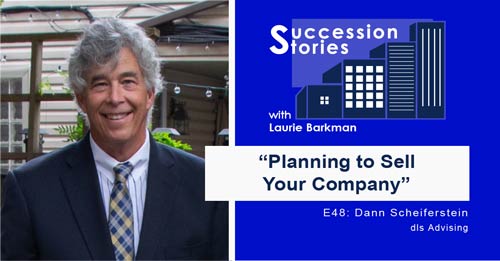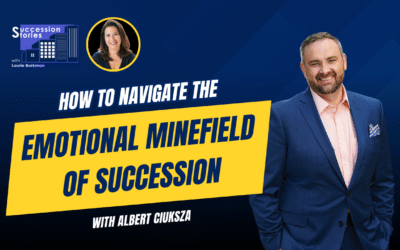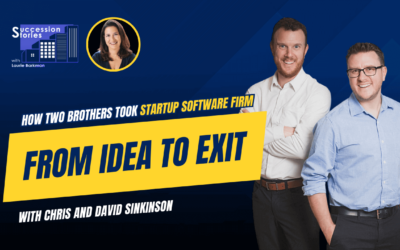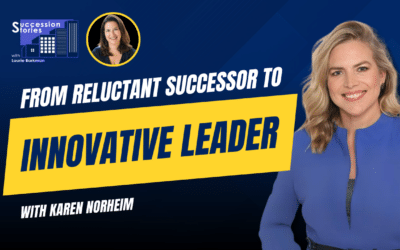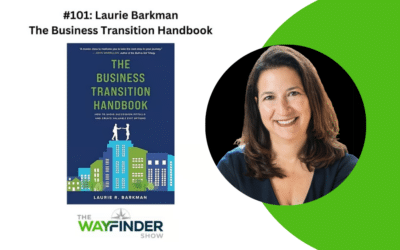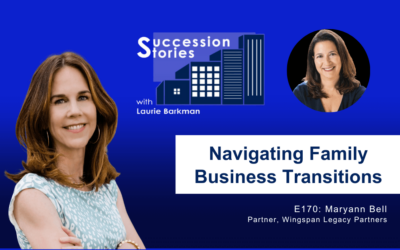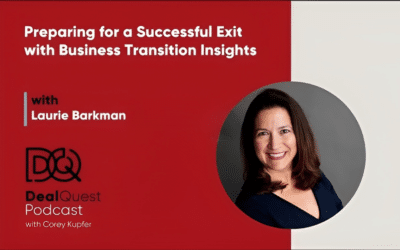-
dls Advising website
- Connect with the show host, Laurie Barkman and sign-up for an insights newsletter to build value in your company. Visit https://www.smalldotbig.com/
Transcript:
Laurie Barkman:
Dann Scheiferstein, welcome to Succession Stories. You and I met recently through the Exit Planning Institute chapter in Pittsburgh, and I just have really enjoyed getting to know you. You’re a super great guy, and I think we have a kindred spirit. I’m so glad to welcome you on the show today.
Dann Scheiferstein:
Thank you, Laurie. Good to be here.
Laurie Barkman:
So let’s start by talking about you and your background. Where did you grow up?
Dann Scheiferstein:
I grew up in a small town in northern Ohio – Amherst, Ohio. I spent the first 28 years of my life in that area; 50s, 60s kind of childhood, just like TV and all of my family and my wife’s family’s from there. So yeah, that was the world as I knew it.
Laurie Barkman:
A lot of people I talked to on the show, I find that there’s an entrepreneurial gene. I have a theory about that. You are an entrepreneur, were there entrepreneurs in your family?
Dann Scheiferstein:
Yes. My grandfather started a business in the 20s in Lorain, Ohio, an insurance agency – She Percent insurance – very original brand at that time. He was someone obviously, I knew, it was my grandfather. As a young person, my dad and his brother went into that business in the mid 50s, 60s and that was my childhood. My life was being part of a family business not working, obviously.
Laurie Barkman:
They didn’t put you behind the desk to seal envelopes or anything?
Dann Scheiferstein:
We’d visit on weekends and hang around and stuff like that, but no, that was about it.
Laurie Barkman:
But you were used to seeing the name on the door, you were used to seeing that identity as an entrepreneur and having that, “Oh, I recognize your name right you’re part of that insurance family,” right?
Dann Scheiferstein:
Yeah, and you know what? I really have to say that the difference was, my father never encouraged us. I had two other brothers, we were five children that he had, still has, and never encouraged us to go on in his business.
Laurie Barkman:
Really?
Dann Scheiferstein:
Yeah.
Laurie Barkman:
Why do you think that is?
Dann Scheiferstein:
Well, I think, because there were five of us and then he had a brother who had three others, and we were all within six years, so there wasn’t just enough room to go around. I really am glad about that because I got all the revealing of the business life of being an owner and entrepreneur without being shoved into a piece of a puzzle, be it insurance or Lorain Ohio or anything like that.
Laurie Barkman:
You weren’t locked into something.
Dann Scheiferstein:
Exactly. I always felt that I would be an independent business person some day, somehow. I had the image of running your own show. Because that’s again, what my dad did. I really thank him for that. Not knowing how deliberate it was then.
Laurie Barkman:
They set the stage for you to have the interest so tell us your entrepreneurship story. How did you get into business? What was your first, or what were the most significant company experiences that you’d like to share?
Dann Scheiferstein:
I guess my first business experience, and first company was absolutely my favorite and most formative.` I worked in a business school, I went to Cincinnati, and I was a sales engineer type of guy because as a biology major and a business guy, it’s sort of like the only thing you can really qualify for, talking to other engineers and being able to communicate with them.
As I got starting my family, I decided that, “If I don’t get out on my own right away, I’m going to be doing this for the rest of my life.” This was the late 80s and being in the industry at that time, there was a lot of heavy industry that was not on the upswing, but on the downswing so, I found an opportunity in the Wall Street Journal opportunity pages. I don’t think they even have that anymore but this is, again, in the late 80s. It had an advertisement for a national business that I started here in Pittsburgh, and it was a franchise that was the third one in the country. The reason it attracted me was because it was like nothing else I’d ever seen. So I check that box on starting a business trying to do something that no one else is doing. I came to Pittsburgh, knew absolutely no one, we didn’t have much of a support group. But it was a great business experience, because I was doing something that had very little competition.
Laurie Barkman:
What was the name of the company?
Dann Scheiferstein:
That was Record Masters.
Laurie Barkman:
What did they do?
Dann Scheiferstein:
We stored records for hospitals. Actually, this was at a time where I knew nothing about records storage. I didn’t know anything about information management within hospitals but it was a simple service concept. We’d take all the physical paper X-ray records from all the hospitals in Oakland and the surrounding western Pennsylvania area, we concentrated them in a warehouse on the north side and then we did 24/7 delivery of those original medical records back to the hospital on a demand basis. That was my only client – hospitals. That was it, so it was a very specific service to a very specific population.
Laurie Barkman:
That was going to be my observation for the business and you can tell us how successful it ended up being, but I think it was a good ending for you on that, because you and I have talked about it offline, but what’s interesting about it is the niching down. You had a specific application, there was a very specific utility and benefit that your specific client niche, which were hospitals, derived, and there was a recurring revenue stream, because there was always a need for record management, and they have limited space and very expensive space in the hospital. So yeah, I could see how that would take off in the right market area.
Dann Scheiferstein:
This was a very excellent market area. That’s how I started my first business. I hired my first person, I got my first warehouse, I got my first client. It was all those firsts, and because we were so unique and new we were inventing the service as we went along. I hate to sound so old, but I bought the first fax machine for Presby Hospital because they were my first client, and it was part of delivering my service. I guaranteed one hour delivery 24 hours a day. The fax machine was just invented then, it cost me like $10,000 and it was supposed to go in the ER, and the president of the hospital at that time, which is a long time ago actually put it in his office, because he didn’t have one. So it was that type of evolutionary thing with a very low tech service of delivering paper records, but utilizing whatever technology was being evolved right at that time, to help facilitate it. It was exciting.
Laurie Barkman:
What was happening with that company?
Dann Scheiferstein:
We ended up being 14 locations across the country. I owned two of them and I did a roll up with one of those locations and the other three largest ones in the country with an investment banker, and that allowed us to get enough resources and go from a lot of small little companies to a $15 million company, and then we bought up the other locations. This is the 90s. Now I’m in the 90s, and lo and behold, we sold that group to Iron Mountain, which was trying to get into health care. We owned it coast to coast, we had all the hospitals in most of the major cities, so Iron Mountain was a company that was at that time a focused business record company. That was how that evolved from a bunch of little locations, Mom and Pop businesses, a roll up, and then an eventual flip to a public company at that time. They had just gone public so yeah, it was a great 90s story – enjoyed every minute of it.
Laurie Barkman:
Really incredible and it’s a great example. As you said, the tech is different today, but the concepts are still valid, which is finding a market niche doing it really well obviously on the financial performance, making sure that you’re scaling it, which it sounds like you were, and, looking for tech opportunities. It makes me chuckle because I think of the fax machine then the razor blade today; Gillette and their model, they basically gave away the razor blades to keep you coming. I think that’s a really great example. What did you do after you sold the company to Iron Mountain?
Dann Scheiferstein:
Well, I only stayed on after that for — at that time, I’ve been with the business for 10 years approximately — I only stayed on about six more months after that and then I actually dropped out for a year and traveled with my family around the world and came back.
Laurie Barkman:
Dropped out. Like a drop out. That sounds like, “Hey, I’m gonna go have some fun.”
Dann Scheiferstein:
It was that cycle of entrepreneurship where you risk a lot, get rewarded, and, “Now what?” I wasn’t in the records business as a career move, I was opportunistic about it, I didn’t train for it and know anything about it before I went into it, so it’s like, you wake up on a Monday morning, and you’re not the president of a company anymore, or the CEO or an owner of anything. It’s a very reflective moment and I was relatively young, I was in my early 40s at that time, and it took me almost four years before I found another business that I felt I could have some success with and scale and that was when I started moving into the therapy services. Again, sort of related to health care, but this is my first time actually working with patients and doctors. On the record side, it was all administration and management of hospitals, never the physician themselves, never entered into our contact point, we were just delivering records, which was a nice way to go from the pan into the fire. I started a physical therapy and pulmonary rehab here in the Pittsburgh area, I was approached by some associates, I was trying to be creative. I called it the gentleman farmer type of transition.
Laurie Barkman:
What does that mean, ‘gentleman farmer’?
Dann Scheiferstein:
It’s like, “Do you really need to bring in the crops to live? Or are you creating a farm for the lifestyle?” That’s where I was sort of looking at that point. Little did I know that I started on a road or a path of establishing rehab services that had an adoption rate that was very difficult to scale up. Again, I’ve had 10 years previously, a lot of success in the business. The first three I’d forgotten about, because those were the zero years where I was 00 sales, and nobody knew what the heck I was doing. I was starting that all over again and sure enough, I find myself after that success with this first company, catering lunches to doctors offices, I am physically going to the restaurant picking up bags, and this is before Panera, picking up bags of food, and taking them because that’s how you got to see physicians at that time, and promoting these rehab services that I had stumbled upon because pulmonary rehab in Pittsburgh was not a widely reimbursed or widely accessible service.
But western Pennsylvania had the third highest rate of COPD in the whole country, because of just the demographics of the smoking and the people in the mining and the steel, etc so I thought, “There’s plenty of patients, they all need this.” But that’s the fallacy of being a gentleman farmer. I forgot to do a lot of research in regards to the reimbursement and this is my introduction to healthcare, and working with institutions as insurance. That was a real eye opener. But I forged ahead. I had been down the road before in regards to trying to establish, and I’m glad to say that company is still operating. There are six locations now here in western Pennsylvania. I sold that to my general manager after about five years because I decided, “Gee, I am just not the right guy to be owning a rehab facility.” It was too clinical. I was not a clinician, I was more of the scale; get the office space, hire the people. I’m glad it’s out there. I’m proud of that, because it does have a great service.
But that also led me to the sleep business. Which again, I didn’t even know about sleep apnea at that time. I was just unaware of that as a condition or a diagnosis and just like going into the records business, my medical director said, “Boy you should turn this into a sleep clinic,” and I go, “But what is a sleep clinic? Never heard of that,” he says, “Well, that’s where people come and get to stay all night, and are tested for sleep apnea,” and it was one of those things that I realized the ability to utilize a facility. A clinical facility during the day for the rehab, and at night for the sleep patients. I go, “This sounds like a great idea.” So I started identifying what it takes, and that really took off. We went from one clinic to about over 20 in about five years. Because sleep apnea at that time was just evolving, my model was to take it out of the hospital and put it into an outpatient model. Because up to that time, you had to actually be admitted to a hospital to actually get a sleep test so here again, I didn’t invent anything other than moving it. I was the only person who was not a physician or a hospital that owned a sleep clinic and so I looked at it completely differently than they did. We set up our rooms like Marriott Hotels with a bottle of water on the side table there and that type of thing so we were able to scale it very quickly and create alignments and partnerships with hospitals and physician groups because there was a significant backlog of testing due to demand for testing.
Laurie Barkman:
And the reimbursement side you had already figured out at that point.
Dann Scheiferstein:
Yes, I was getting smarter, so that was a very dramatic scale up here in Western Pennsylvania.
Laurie Barkman:
That’s a brilliant way to really leverage the assets that you had, because you created a 24/7 model pretty much, I guess.
Dann Scheiferstein:
Oh yeah.
Laurie Barkman:
Weekends were big too?
Dann Scheiferstein:
Weekends were big for the sleep business. Absolutely. It was a fun ride. It was funny, I put the businesses together and then three years later, I took them apart again, because the sleep business got so big, it was crowding out the rehab. That’s when I sold the rehab away and so I just focused on the sleep at that time.
Laurie Barkman:
And what’s the name of the sleep business?
Dann Scheiferstein:
It was Lifeline Sleep. Still operating today.
Laurie Barkman:
Did you sell that business too?
Dann Scheiferstein:
Yes, I sold that to my partner at the time. He was the clinical guy, I was the financial sales business strategy guy. Again, I didn’t even know what all those squiggly lines meant, on the computer and the paper that they were measuring. But you didn’t have to if you had the right people working with you, and I sold that to my partner at the end of 2012.
Laurie Barkman:
That’s fantastic. Did you take another family break after selling that company?
Dann Scheiferstein:
[Laughs] No. At that time everybody’s in college, they’ve had enough of traveling with me so no. I went into the advising business. What else do you do after all that?
Laurie Barkman:
Well, that is the exploration. You said it earlier where after you sold the first company you took about four years to figure out what your next was so now at this point, you’ve you’ve worked really hard. You’ve built these two companies, you’ve sold them, and now you’re thinking about your next. What led you to conclude that you wanted to be an advisor? And what are you advising? This is the present day, this is how you’re getting into what you do now with clients and, spoiler alert! You work with clients on exit planning so it’s no surprise, but how did you get to that point to take that leap and say, “Yeah, I want to advise other business owners on exit planning,”?
Dann Scheiferstein:
Well, when I sold the sleep business, I’ve been in this position before, it’s like gearing and waking up on Monday morning, “What am I going to do now?” And I did not have a good answer for that and you’d think I would be a little bit better prepared, but I wasn’t. I was actually connected to a company that was looking for a transitional president mentor for a key individual within the company. They asked me if I’d be interested and I looked at that as my entry into advising, even though I was working for basically the board of directors. It was the first time I worked for somebody in about 25 years. I thought, “You know what, I need to do this, I need to have this kind of transition from being an owner because I don’t want to be an owner of anything anymore. I think I’m done with that.” That’s how I started. I felt that was my entree into advising because my role even though it had a title, and it was over 100 employees, etc, etc, my role was just to be a babysitter to the business and maintain its integrity, but really mentor someone. That’s really what got me into advising because I loved the mentoring part. I did a great job of that and I started my own businesses, because I’m very much a collaborator. I’m very much a delegator. I like to be out creating and identifying the need and providing the resources to fill it.
That’s where advising was a great fit for me at that time, because now I have a lot of experience with a lot of different people and a lot of different ages and a lot of different industries. I am not industry specific. I’m a perfect advisor, master of nothing, dabbled in everything. That’s what led me to advising and then I went from the mentoring president to a full time advisor with a very select group of clients where I was more of trying to scale their business and also take young transgenerational succession, so that they can scale up within their new responsibility and also some startup businesses. That was my entry into advising. I did that for about three or four years and after four years of going, I had a tendency to be pulled down into the weeds. Because I became very close to those companies and their executive teams and I was in there and didn’t have a lot of clients. So I spent a lot of time with a few clients. After about four years of that, I went to one of my mentors, and I said, “You know, I’m exhausted, this is a lot of work.” He says, “You know Dann, you should check out exit planning,” and I go, just like with the records, “What is that?” It’s like my whole career I get to these ‘what is that’ moments. He said, “That’s when you just work with the business owner, and prepare them to exit an already established business.” To me, I felt like I’ve been studying for that for the last 20 years, because I really liked working with business owners. I think I obviously have a rapport with them, spend a lot of time with them. I am not industry specific. I’ve gone to a lot of different places. That’s when I started investigating ‘what is exit planning’ and Googling it up and boy, it’s a real thing. That’s what led me to where I am now for the last few years, which is, 100% of my focus is on exit planning and helping owners.
Laurie Barkman:
Gotcha. I like how you describe exit planning. You and I have had a lot of conversations about this because we are in the ecosystem. My focus is on the value building side and you talked about that scaling up and, I like how you phrased it, generational succession scale up and the innovation side and really getting the business to where it could get to the point of readiness for exit. There’s two sides of that coin and you addressed them for yourself. One was the business readiness side and the other is the owner readiness. You felt this for yourself and I’m sure now you see it with clients that it is not easy to be ready, and that Monday morning feeling after the transaction. We collectively want people to be happy in their next, whatever that is. I want them to be happy about it, but that doesn’t always happen. I wanted to talk about that and you can share with me from your experience but also, if you have client experiences where there isn’t necessarily a clear path to letting go, and what do you think about that? If someone’s listening today, and they’re thinking, “I’m an owner, I’m not ready to let go, this is hogwash.” Five years away, 10 years away, maybe that’s one way to think about it. But if you’re maybe closer in, less than five years away and your definition, it’s very individual, why you personally would say you’re ready, you’re not ready. What are those things that you’ve observed in terms of why someone is more or less ready for transition?
Dann Scheiferstein:
A lot of times, it’s outside circumstances and they still, personally, may feel they’re not ready. But they feel like, let’s face it, we’re all going to exit our business sooner or later, and it’s becomes a point in time. They get a lot of advisory help either from family, or the advisors around them that, “You need to lay the foundation,” let’s put it that way and I think the opportunity is that there are very little descriptions that owners can latch on to how to do that. Even passing a business on to your executive team or your family sounds simple, because they know the business, or they’ve been in the business but that isn’t the same as having a successful transition of that business. Particularly the more successful the businesses are, the more complicated the businesses are; the more employees, the more people that depend on the business, the more difficult it is to transition. Unless you have a plan, and you have vetted that plan with the successors the ramifications of the quote unquote, clients, or the productivity, quality, all those kinds of things on the business side, there’s so many risks that quote unquote, pop up.
Every table’s got two sides. One is increasing the value, to get the highest value for the owner so that they are financially free. The other side is the risk side. One’s value, the other’s risk, how do you diminish or de-risk the business so that when that transition happens, the eventual owners have the most likelihood of succeeding? Not just for two years. Their success should last for hopefully decades, so it’s not a simple process. And it’s not that it hasn’t been going on for 1000s of years. It has, ever since the farm to the oldest son type thing, but that the amounts of money and information and dependency in today’s business world and the speed of change, makes the these transitions much more critical and I think that there are tools, be they advisors be they processes that have been in place for many years due diligence, etc. to help with that.
You and I are all about the happy exit. 50% of business owners after they leave their business, a year later, are not happy and that is a startling percentage. Why is that? I mean, they left on their own accord, it’s usually not the money that’s usually personal. It’s usually that they didn’t know what to do next. They weren’t ready or they didn’t leave the culture. I think part of the process of planning is the amount of variables that you have to deal with and the owner or founder leaving and/or transitioning both on the business side and the personal side. Like, “Where do I start?” and it’s difficult. Been there. It was a lot easier for me; the younger you are the easier it is, the older you are the harder it is. It’s not a surprise.
Laurie Barkman:
Well, it’s about options, and I think it’s also about being happy. Happy in your next, to me, means you’re being pulled into something you’re excited to go on that other side, versus feeling pushed out of something that feels more negative and really could feel more like a loss.
Dann Scheiferstein:
Very good point.
Laurie Barkman:
That 50% statistic is pretty shocking, because you think, on the surface, “Oh, so and so sold their company, they must feel great about it.” It doesn’t always happen that way. They don’t always feel great about it.
Dann Scheiferstein:
Yeah, and they aren’t very verbal about it, either. That’s why it’s one of those things that you don’t hear about. The ability to have an impact on business owners and make them more ready, and more aware, and happier and lower that unhappy percentage is available to us. That’s why what I’ve been doing the last two years just feels so rewarding. I work with a lot of people, but the people that I do work with they’re talking to another business owner. I am not a lawyer, I’m not an investment banker, I’m not a transaction person. I work with them on a monthly basis, meet with them for a few hours here and there, they’re busy. But you create that kind of dialogue and that rapport, that they really feel like they’re getting somewhere that they hadn’t been able to address before. They have never talked to someone like me before trying to help them with a very personal issue with their business.
Laurie Barkman:
Yeah, you walk in their shoes. You can understand the emotional side, there’s an emotional side to this, for sure, as well as the business side. Winding down, here are a couple of last questions for you. As you’ve talked to owners, certainly over the last year, with the pandemic, in your conversations, what are you hearing about owner readiness? Are you finding that the timing of their readiness has shifted? I’ve seen some data that is showing that there is a shift, and I’ll share what I am hearing after you share it. What you’re hearing?
Dann Scheiferstein:
What we’re hearing is that, yes, there’s an acceleration. We were on 10 years of a great run of business growth. Business owners are human like all of us. The last year has been dramatic and now everybody is looking at the risks of their business and that is a big motivator for business owners to try to start a process to at least control or start identifying the issues that might put their business at risk or their exit at risk. It’s really accelerated things.
Laurie Barkman:
That’s consistent with what I’m hearing too. This is data from the Value Builder Company that I work with, and we should mention that you’re working with Navix and you’re getting a lot of your data from Navix, as well as from your conversations one on one. The Value Builders survey showed that as well, essentially the timeline, and it was a significant change in mindset. It was more of a pull in like they’re more ready now within five years, as opposed to, more on the later side, that that timing had sort of shifted in. Some of that reasoning was because business owners have gone through the 2008-2009 recession, now gone through this, and they’re really ready. They don’t want to go through another recession. A lot of unknowns, so yeah, that is definitely consistent. Last question for you. Let’s see. I’m thinking because I want to make sure that we cover everything so let me just ask you a general question. Is there anything that we didn’t cover today that you’d like to share?
Dann Scheiferstein:
As a summary, for business owners, who are the ones I think listen to your podcast, it’s never too early to start planning a transition. The more you understand about the elements the better off you’ll be, which is planning 101. Your wealth manager will tell you that, your parents have told you that for years before, and as a parent, you tell your children that. As an advisor, I think that’s the one thing I will put out there to all business owners; get started on some planning.
Laurie Barkman:
I love that and I think the corollary with that is make sure you write it down, because the plan that’s in your head is not a plan.
Dann Scheiferstein:
Exactly.
Laurie Barkman:
It’s good insight, and so, very last question for you, Dann. It’s been great to talk to you today. Do you have a favorite quote that you’d like to share about?
Dann Scheiferstein:
Well, it’s very basic, and it was given to me by a husband of an associate who owned a business also. He pointed out something to me. I was probably in my 30s at that time, and he said, “Dann, every business has a birth, a life and a death,” and I looked at him because I was in an MBA school and a young guy. I dealt with numbers and products and widgets and services, but to humanize that lifecycle of a business that way, that is something that’s always stuck with me. It really made me more of a better business owner, because it is the lifecycle of a business. You don’t have to look at it as all the metrics. but as something you’ve founded, gave birth to, you scale it, or you give it life, and you bring it to whatever type of conclusion and then the exit or the death, whatever that may be, it doesn’t mean it’s going out of business, it can be a lot of different transitions. But that is sort of that definition of death and I guess that’s why I’ve had so many businesses in my life. I’ve always seen that as a positive thing, and not as a negative thing.
Laurie Barkman:
That fits you to a tee – a very positive person. Before we go, if you want to share, how can people find you and connect with you? And then also, because we didn’t talk a lot about Navix, just put a little bit of an underline on who they are and how you’re associated with them? And how would people learn more about Navix?
Dann Scheiferstein:
You can reach me on my DLS advising website, which mentions Navix. Significantly, I am an independent consultant for them. They are my back office, they have all my intellectual property. I use their intellectual property for my processes and they’ve been in this for 25 years, they’re great. There’s no reason to reinvent the wheel with a lot of things when dealing with businesses. That’s my association with Navix and where I am in my career, it’s exactly what I want. I want to deal with the business owner, I don’t want to deal with all the assessments and the deliverables that we present, they help create those for me. So that’s my association with them and it works great.
Laurie Barkman:
That’s great.
Dann Scheiferstein:
All right. Well, thank you Dan. It’s been a pleasure speaking with you on air. We talk off air all the time. I look forward to getting to know you even more after today of course and having the audience learn about you and learn about exit planning. Thank you so much for taking the time.
Laurie Barkman:
Thank you Laurie. It’s a pleasure. It really was. Take care.

